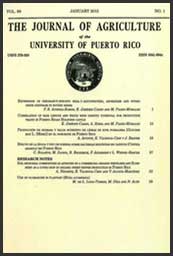Resumen
Se evaluó el efecto del sexo (hembra o macho intacto) y tipo de animal (carne, TC; o leche, TL) sobre atributos de calidad del músculo Longissimus lumborum de 89 bovinos comerciales sacrificados en Puerto Rico, todos con ocho incisivos permanentes (>53 meses de edad). La carne de TC tuvo un pH mayor (P<0.0001) que la de TL (5.75 vs. 5.40), siendo los machos TC y los de TL de mayor y menor pH (5.99 y 5.32); habiendo así interacción de sexo por tipo (P=0.0003). Referente a parámetros del color, las hembras TC y los machos TL obtuvieron valores de L* más bajos (carnes más oscuras), constituyendo otra interacción de sexo por tipo (P<0.0001). Los machos mostraron valores de a* y b* mayores (carnes más rojas y amarillas) a los de las hembras (P<0.05). Las hembras superaron a los machos (P<0.0001) en concentración de grasa intramuscular (9.13 vs. 3.06%) y hubo una ventaja no significativa a favor del TL sobre el TC (8.90 vs. 5.87%). Un alto pH se asoció con alta retención de agua (P<0.0001). Los valores Warner-Bratzler Shear (WBS) y los de terneza determinada por un panel sensorial no adiestrado mostraron tendencias no significativas a favor de las hembras en general (WBS: 6.13 vs. 7.20 kg) y para el TC sobre el TL dentro del sexo masculino, (WBS: 6.69 vs. 7.71 kg). El panel sensorial determinó mayor jugosidad en la carne de machos frente a la de hembras (4.85 vs. 4.16 en escala del 1 al 8; P<0.0074).

